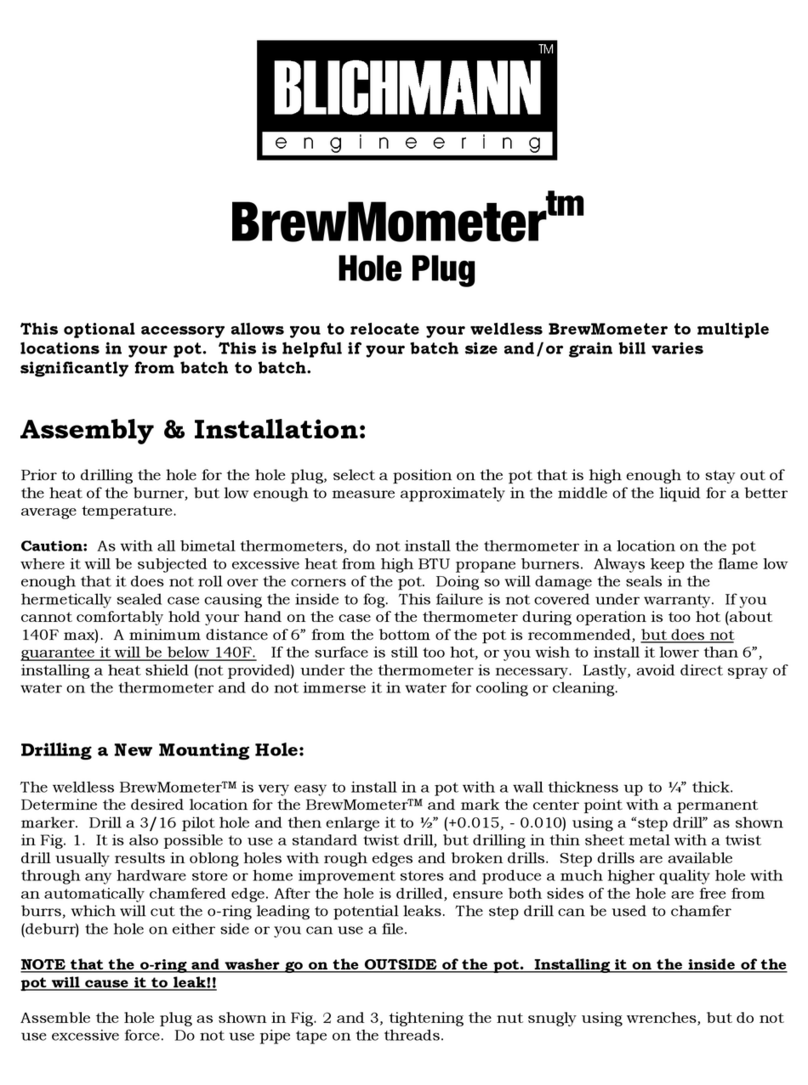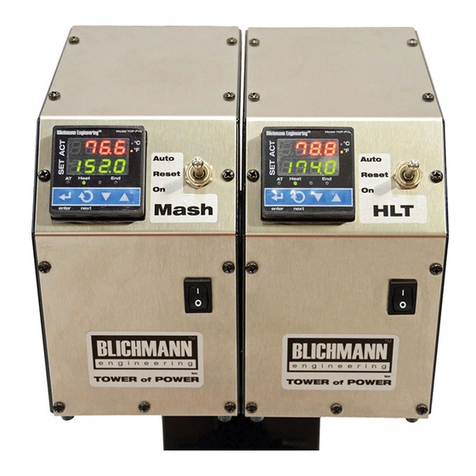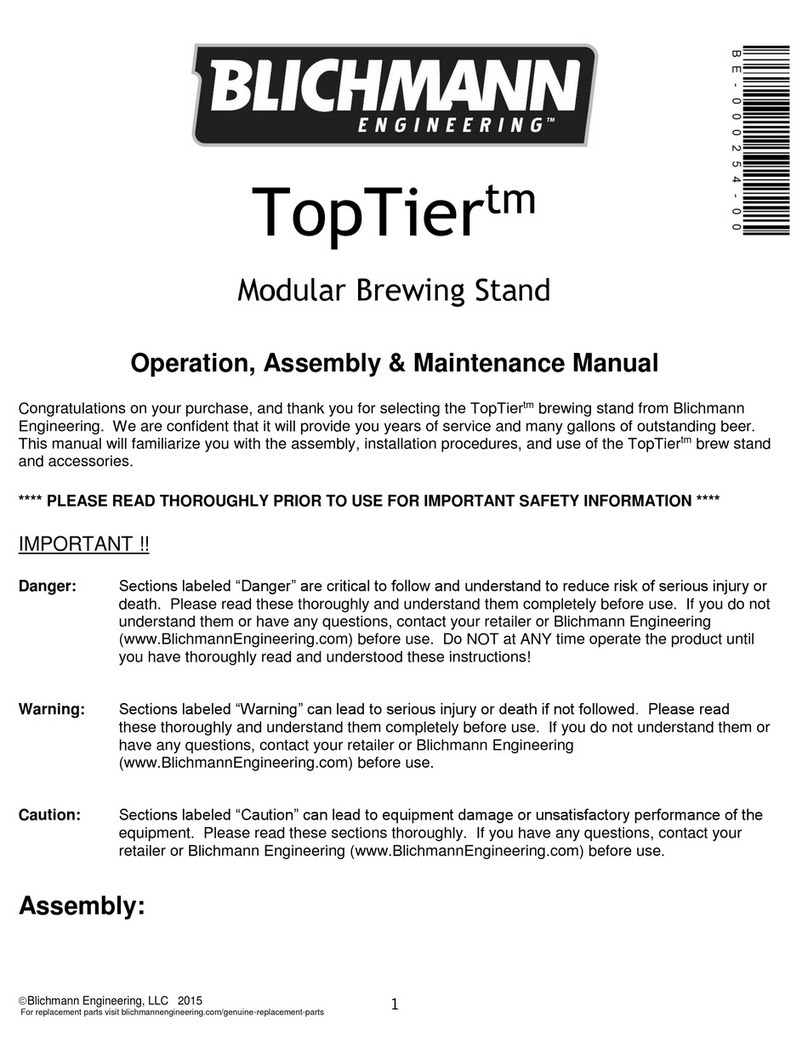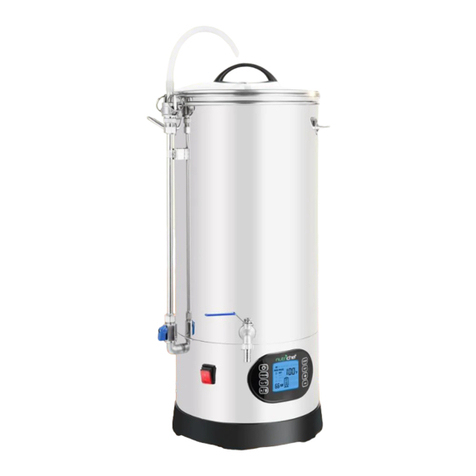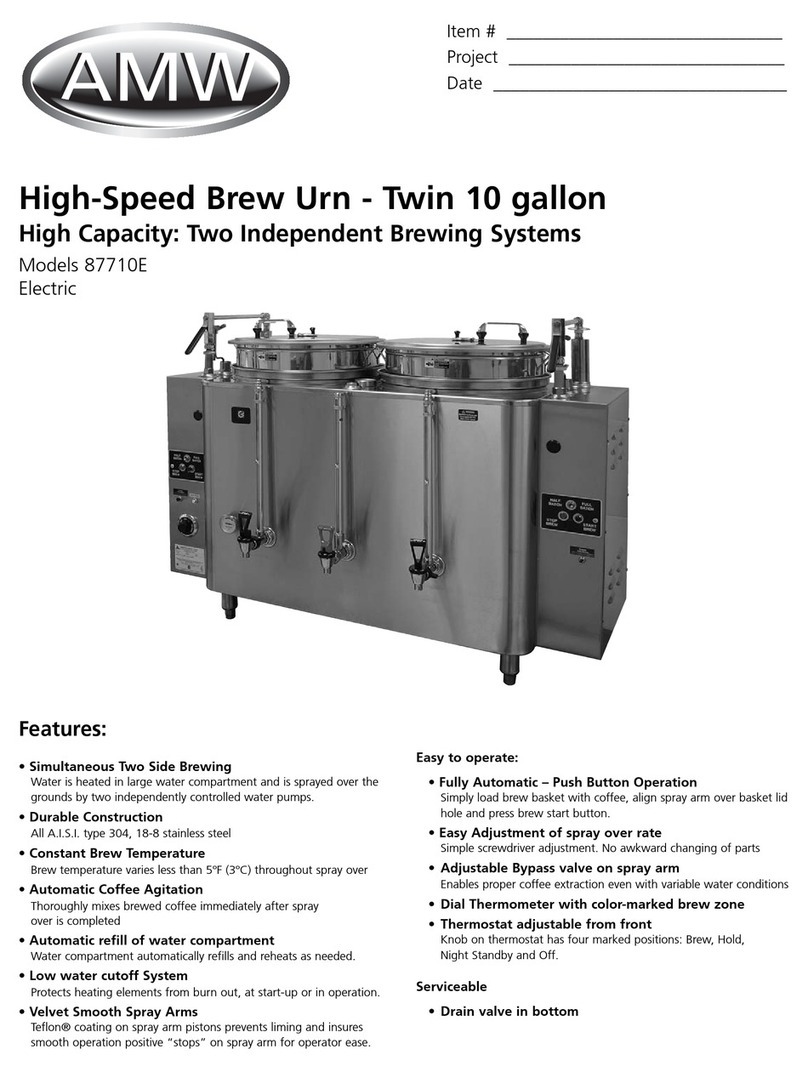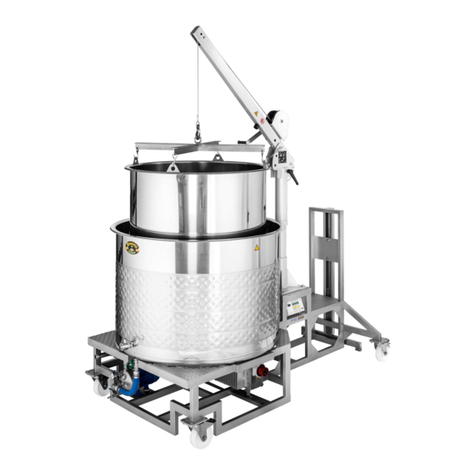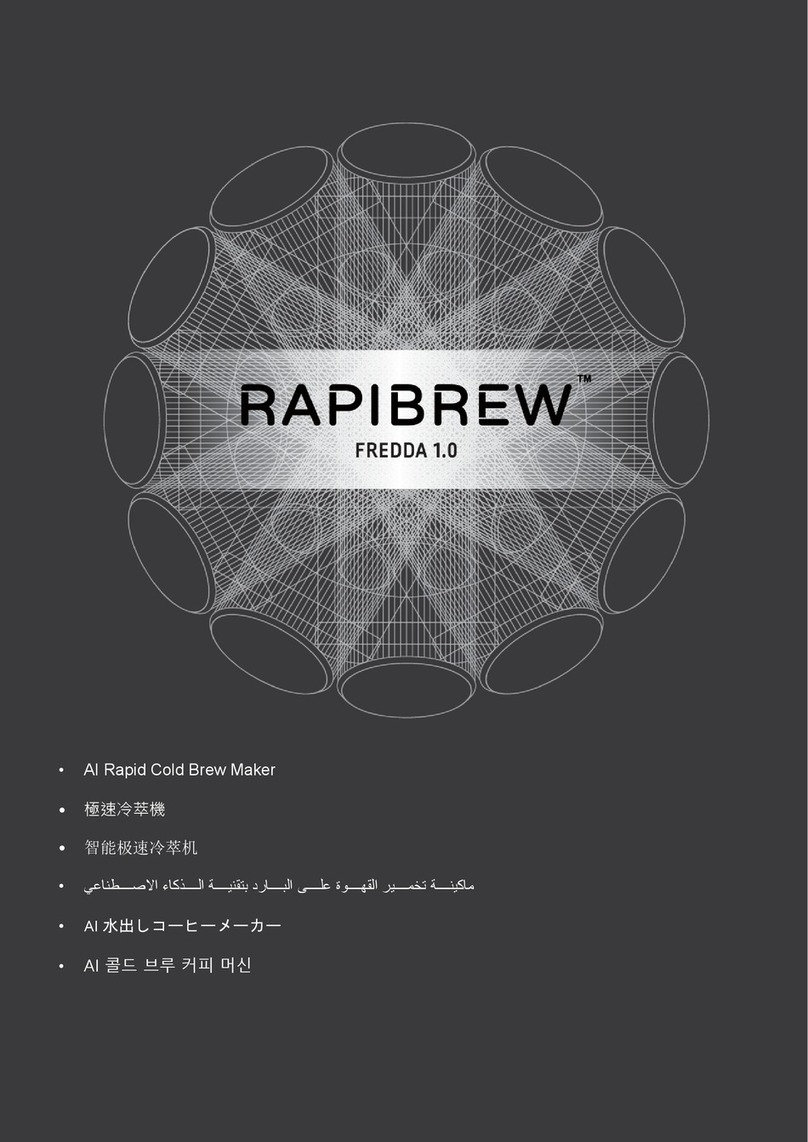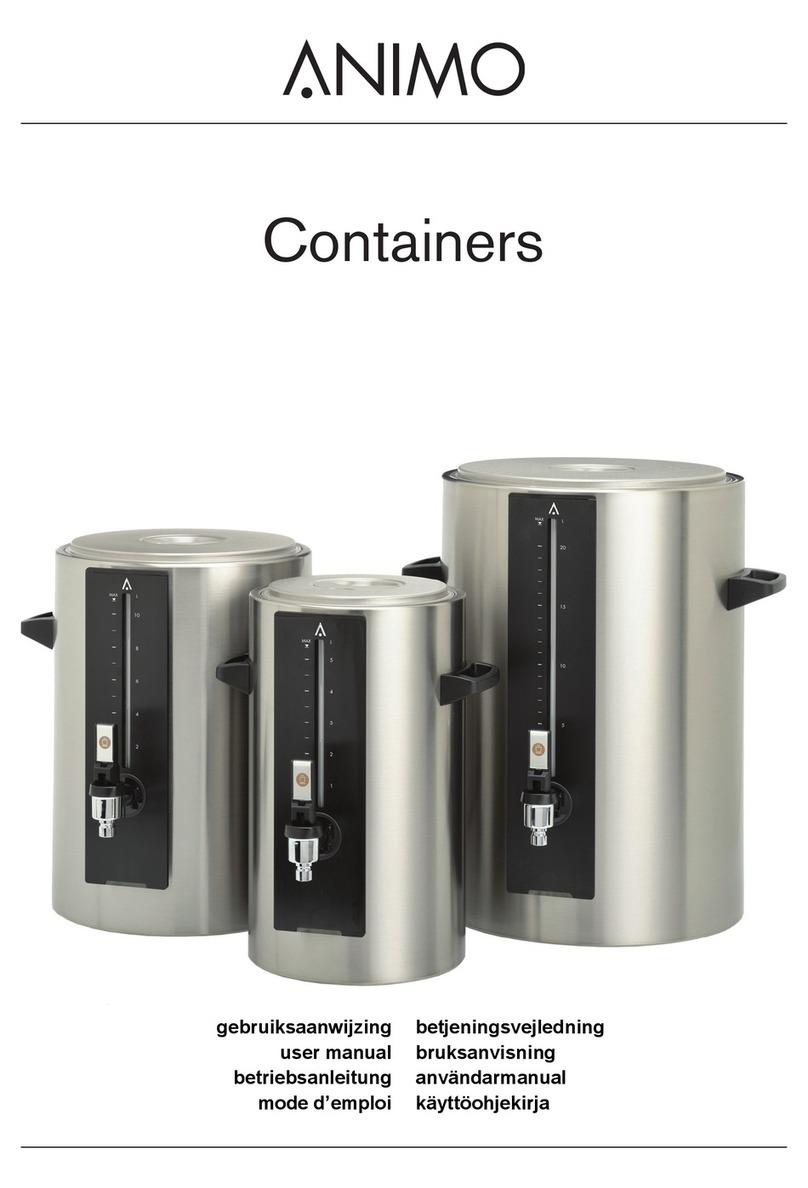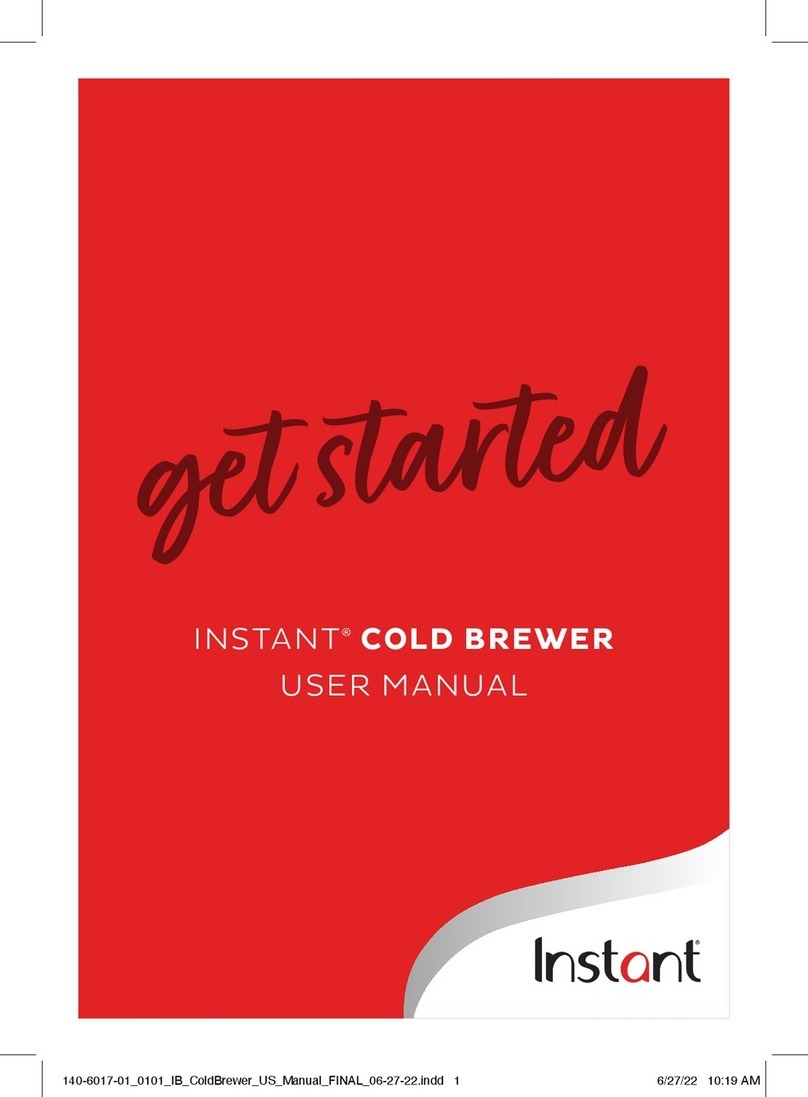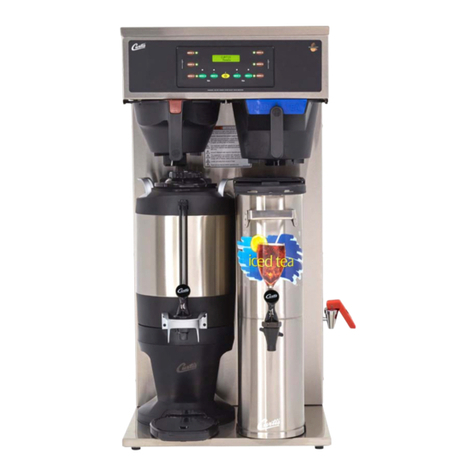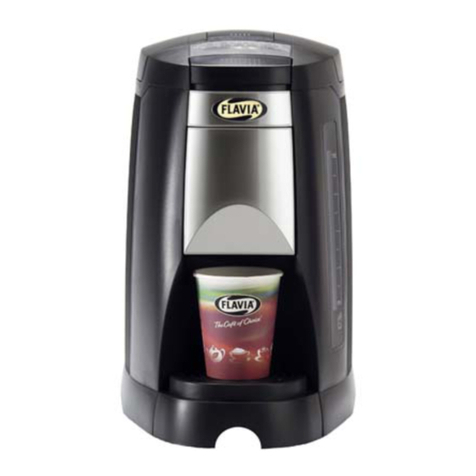Blichmann BoilerMaker Surface Installation instructions

BoilerMaker Surface™ V1 © Blichmann Engineering, LLC 2023
For replacement parts, visit: blichmannengineering.com/genuine-replacement-parts 1
BoilerMaker Surface™
Assembly, Operation, & Maintenance
Congratulations on your purchase, and thank you for selecting the BoilerMaker Surface™
brew kettle from Blichmann Engineering. We are condent that it, and our suite of
accessories, will provide you years of service.
Sections labeled “Warning” can lead to serious injury or death if not followed. Please thoroughly read these sections
and understand them completely before use. If you any questions, contact your
retailer or Blichmann Engineering (www.BlichmannEngineering.com) before use.
Sections labeled “Caution” can lead to equipment damage or unsatisfactory performance of the equipment. Please
read these sections thoroughly. If you have any questions, contact your retailer or Blichmann Engineering
(www.BlichmannEngineering.com) before use.
Sections labeled “Important” should specically be followed to ensure satisfactory results
WARNING:
CAUTION:
IMPORTANT:
IMPORTANT INFORMATION
PLEASE READ THIS MANUAL THOROUGHLY PRIOR TO USE
FOR IMPORTANT SAFETY INFORMATION!
What’s In the Box?
Thermometer (Optional)
Power Cable
Level Gauge (Optional)
Valve (Optional)
Kettle
Lid

BoilerMaker Surface™ V1 © Blichmann Engineering, LLC 2023
For replacement parts, visit: blichmannengineering.com/genuine-replacement-parts 2
TABLE OF CONTENTS
First Time Cleaning..........................................................................................................
Dimensions And Weight..................................................................................................
Power And Connections..................................................................................................
Boil Kettle........................................................................................................................
-Assembly
-Operation
Hot Liquor Tank..............................................................................................................
-Assembly
-Operation
Mash Tun.........................................................................................................................
-Assembly
-Operation
Valve Assembly................................................................................................................
-NPT Linear Flow Valve
-Cleaning The Linear Flow Valve
-Installation Of The Dip Tube
-Optional Rotating Dip Tube
-Tri-Clamp Valve Assembly
Use Of The Level Gauge....................................................................................................
Maintenance....................................................................................................................
Dry-Run Thermal Breaker Reset Instructions..................................................................
NPT To Tri-Clamp Adapter For Accessories......................................................................
Kettle Accessories............................................................................................................
3
4
4
6
7
8
9
13
14
14
14
15

BoilerMaker Surface™ V1 © Blichmann Engineering, LLC 2023
For replacement parts, visit: blichmannengineering.com/genuine-replacement-parts 3
After you have received your new equipment and removed it from the box it is very important that you properly clean the equipment thoroughly
with a general detergent such as Dawn dish soap. This will remove any debris and oils that may have been left behind from shipping and the
manufacturing processes.
Cleaning and sanitizing all your home brew equipment before every use is an important aspect of brewing. Using good cleaners and sanitizers
can make the difference between having a great beer and a spoiled one. Good preparation for your upcoming brew day is key. Make a checklist
of the equipment you will be using and note whether it needs to be sanitized or only cleaned. In prepping for your brew day, always make sure
your equipment is ready to go when you are.
IMPORTANT INFORMATION
Caution: DO NOT SUBMERSE KETTLE IN LIQUID
FIRST TIME CLEANING
ALWAYS START WITH A CLEANING AGENT
Before you do any sanitizing, you need to thoroughly clean your equipment. Sanitizers do not work on equipment with soils on the surface, and
bacteria and wild yeasts will remain. It is always best to immediately wash your equipment after use while the soils are soft and easier to
remove.
There are a number of good cleaning agents on the market. One Step™, Straight-A™, and Powdered Brewery Wash™ (PBW) are three of the
most popular. These products may be used on bottles, fermenters, and other equipment. Cleansers should be rinsed after use. Don’t soak your
equipment in a cleansing solutions for longer than the time recommended on the packaging, or you can damage your equipment.
As with ALL chemicals. ALWAYS thoroughly read the instructions, material compatibility, and safety warnings. Never use more than the
recommended concentrations or soaking times or you may damage your equipment.
Cleaning Stainless Steel and Aluminum
For general cleaning of stainless steel and aluminum, mild unscented detergents, PBW, or percarbonate-based cleaners are
excellent choices. Bleach should not be used to clean or sanitize stainless steel or aluminum as it will corrode and pit them.
SANITIZING
Only when your equipment is clean, can you sanitize it.
All items that contact the wort or beer below 140F need to be sanitized. This includes the fermenter (including the lid), airlock,
rubber stopper, yeast rehydration or starter container, thermometer, funnel, spoon, and siphon etc. On bottling day, bottles,
caps, hoses etc. also need to be sanitized. Chemical sanitizers can be prepared in a bucket and used throughout the brew day.
Chemical sanitizers are by far the most common. Most can be used on metal, plastics and glass. Most do not require rinsing; a
good feature since your tap water, particularly well water, may contain small amounts of bacteria. Again, always follow the
manufacturer’s recommendations for concentration, contact time, and the need to rinse before use.
Five Star Chemicals™ StarSan™, and Iodophor are the most popular sanitizers on the market. Always use according to the
manufacturer’s directions.
If you have a particularly tough stain, liked burned malt extract, stains, or other buildup, Barkeepers Friend (oxaylic acid) works
very well to remove them from metallic surfaces. This product is available at your local grocery store.
AFTER USE CLEANING
For keeping your equipment clean and looking new, we strongly recommend cleaning immediately after brewing as soils and
residue will be much easier to remove before it dries. Never toss components in a bucket of cleaning agents “to clean tomorrow”
as these chemicals may damage the product if you exceed the recommended contact time.
Once you’ve thoroughly cleaned your stainless products, wipe them dry with a towel and let them air dry thoroughly. A clean
surface will instantly passivate once it is dry, leaving a durable corrosion resistant surface.
John Palmer also has a more in depth discussion about removing rust and how to passivate stainless steel at this link -
https://bit.ly/2VrZ1u8.

BoilerMaker Surface™ V1 © Blichmann Engineering, LLC 2023
For replacement parts, visit: blichmannengineering.com/genuine-replacement-parts 4
DIMENSIONS AND WEIGHTS
POWER AND CONNECTIONS
BoilerMaker
Surface Kettle
Size
Power Amp Receptacle
(NEMA)
Voltage GFCI Breaker Size
10 Gallon 3500 14.6 L6-30 240 30
20 Gallon 5500 23 L6-30 240 30
BoilerMaker™ Brew Kettle Models (gal.) 10 20
Recommended Boil Capacity (nished batch size) 5 10
HLT Capacity (approximate) 8 17
1.00 qt/lb (Mash Capacity of grain at 75% full) 24 49
1.25 qt/lb (Mash Capacity of grain at 75% full) 20 41
1.50 qt/lb (Mash Capacity of grain at 75% full) 17 35
1.75 qt/lb (Mash Capacity of grain at 75% full) 15 30
2.00 qt/lb (Mash Capacity of grain at 75% full) 13 27
Approximate lauter rate (gpm) 0.19 0.33
Min Recirculation rate (gpm) for RIMS or HERMS 0.75 1.25
Kettle dead space (gal.) 0.13 0.22
Volume to thermometer stem (gal.) 4 8.25
Weight 18.1 lbs 28.8 lbs
Height 22” 26.5”
External Diameter 14.13 17.75
Lip Diameter 14.38 18.38
Warning: The Surface™ electric kettle is only to be used in conjunction with a Ground Fault Circuit Interrupter
(GFCI) protected power source. If you are uncertain about the status of your power source contact a licensed and
qualified electrician familiar with National Electric Code standards before proceeding. Operating the BoilerMaker
Surface™ heater in any fashion other than described in this manual can result in personal property damage, injury,
electrocution or death.
Warning: NEVER plug the Surface™ electric immersion heater directly into a power source. ALWAYS use a power
control device capable of de-energizing the heater coil.
Warning: NEVER plug in or unplug the heater cord when energized. Doing so will result in arc damage to electrical
connections.
Caution: Before connecting and energizing the Surface Kettle, verify that it has at least 1in of water or wort covering
the bottom of the kettle.
Warning: Never energize the Surface Kettle without the bottom fully submerged. “Dry firing”the Surface™ will cause
the heating element to reach excessive temperatures which can create a dangerous situation which can result in
product damage or personal injury.

BoilerMaker Surface™ V1 © Blichmann Engineering, LLC 2023
For replacement parts, visit: blichmannengineering.com/genuine-replacement-parts 5
*** Safety should be the highest priority of any brewer. Use common sense! ***
Do not IN ANY SITUATION lift or move any kettle when full with water. A kettle full of hot water may
easily be spilled causing burns. Use a pump or siphon/gravity drain to move liquids from one kettle to
another! Pots of this size are extremely heavy when full and lifting can cause back injury and severe
burns. The handles are provided solely for moving the EMPTY kettle. Do not risk injury to yourself or
others to save a few minutes of inconvenience.
ALWAYS brew on a stable surface to prevent accidental tipping.
NEVER brew where children are, or may be present, and never leave your brew kettle unattended.
WARNING:
CAUTION:
DOS AND DON’TS
NEVER:
• NEVER leave this equipment unattended
• NEVER allow children near this equipment
• NEVER heat cooking oil with this equipment
• NEVER operate on soft, uneven surfaces like dirt, gravel, or asphalt
• NEVER use near or with combustible chemicals, gasoline or other flammable vapors or liquids
• NEVER bypass the GFCI circuit protection
• NEVER operate any equipment with frayed or damaged power cables
• NEVER expose electrical connections to moisture
• NEVER connect heater cable assembly directly to power source
• NEVER modify or alter the supplied electrical cables or connectors
• NEVER operate kettle with higher than rated voltage
• NEVER unplug kettle when energized
• NEVER energize the kettle without a minimum of one inch of liquid in the bottom.
ALWAYS:
• ALWAYS use kettle with rated voltage
• ALWAYS unplug kettle when de-energized
• ALWAYS use on level and stable hard surfaces
• ALWAYS connect to a GFCI circuit
• ALWAYS check power cables and connectors for signs of damage or wear prior to each use
• ALWAYS use approved control device between heater and GFCI power source
• ALWAYS use genuine Blichmann Engineering replacement parts
• ALWAYS unplug before moving
• ALWAYS allow the brew kettle to fully cool before handling
• ALWAYS wear appropriate personal protective equipment, such as gloves, clothing and footwear to prevent
burns and scalds

BoilerMaker Surface™ V1 © Blichmann Engineering, LLC 2023
For replacement parts, visit: blichmannengineering.com/genuine-replacement-parts 6
ASSEMBLY
Connect the power cable to the receptacle of the Surface™ and to a power or temperature controller, such as the
BrewCommander™(sold separately).
Install the optional Brewmometer™, per its product specific assembly manual, to observe temperature. Alternatively,
install your controller’s optional temperature probe into the kettle to maintain temperature.
Install optional accessories as needed, referring to the later section of this manual for assembling valves, and any
manual specific to the optional accessories for their assembly.
OPERATION
Whirlpool Kit (optional) - Recirculate through the whirlpool arm, at the end of the boil, to collect hop matter
and other solids in the center of the kettle as well as decrease chilling time with an immersion chiller. This kettle is
compatible with immersion style heat exchangers as well as external heat exchangers like the Therminator™.
If using a temperature probe, be sure that it is always submerged in liquid during use. Read the temperature on the
displace screen of the controller or read from an optional analog thermometer directly installed on the kettle. The Boil
Kettle is best operated using power control, adjust your power up or down to achieve a rolling boil that is not foaming
over.
Rotating Dip Tube (optional) - Use of a rotating dip tube allows you to pull clear wort from above hops and trub
that have settled on the bottom of the kettle. While transferring out of the kettle at the end of the boil, start with the
dip tube oriented horizontally and rotate downward until desired liquid level is achieved.
Tips: To prevent boil overs, add fermcap or other foam suppressant at the start of the boil. It is standard practice to
boil with the lid off to allow the escape of volatile compounds that may poorly affect the flavor of your beer.
BOIL KETTLE

BoilerMaker Surface™ V1 © Blichmann Engineering, LLC 2023
For replacement parts, visit: blichmannengineering.com/genuine-replacement-parts 7
ASSEMBLY
Connect the power cable to the receptacle of the Surface™ and to a power or temperature controller, such as the
BrewCommander™(sold separately).
Install the optional Brewmometer™, per its product specific assembly manual, to observe temperature. Alternatively,
install your controller’s optional temperature probe into the kettle to maintain temperature.
Install optional accessories as needed, referring to the later section of this manual for assembling valves, and any
manual specific to the optional accessories for their assembly.
OPERATION
Fill the kettle to no more than 80-85% full to allow for expansion of the water as it heats. The Hot Liquor Tank is best
operated using temperature control, setting your controller to Auto with a specified set temperature. Be sure that the
temperature probe for the controller is always submerged in liquid during use. While draining the Hot Liquor Tank,
de-energize the Surface when liquid level reaches the temperature probe to avoid over-heating the liquid or a dry-fire
condition. Damage to the kettle may occur.
Herms Coil (optional) – The herms coil is used to maintain mash temperatures
by recirculation the wort, from the Mash Tun, through the heated Hot Liquor Tank.
Set the temperature of your Hot Liquor Tank to be 5 degrees above your desired
mash temperature (3 degrees if using a Whirlpool Kit). Recirculate your mash water
through the Herms Kettle. See the HERMS Coil manual for more information.
Whirlpool Kit (optional) - Use the Whirlpool Kit and a pump to re-circulate water through the Hot Liquor Tank to
increase heating efficiency. This reduces time to strike by 30%, and reduces the HLT-MP temperature differential by a
couple degrees.
HOT LIQUOR TANK

BoilerMaker Surface™ V1 © Blichmann Engineering, LLC 2023
For replacement parts, visit: blichmannengineering.com/genuine-replacement-parts 8
ASSEMBLY
Connect the power cable to the receptacle of the Surface™ and to a power or
temperature controller, such as the BrewCommander ™ (sold separately).
False Bottom - To install the false bottom, first remove the dip tube. Place the false
bottom on the stepped bottom of the kettle with the “buttons” facing upward and
the support feet down (shown in Fig. 1). Note that the 10-gallon false bottom does
not have support feet. Install the large washer onto the dip tube, and then insert the
dip tube into the false bottom hole.
(NPT KETTLES ONLY) - Inserting the diptube through the false bottom hole on NPT kettles is more difficult than Tri-
Clamp kettles. Place the dip tube in the bulkhead fitting (shown in Fig 2). Position the hole in the false bottom close
to the dip tube and rotate the dip tube until it engages the hole. Rotate the false bottom into place (shown in Fig. 3).
Push the dip tube into place and slide the washer down to cover the hole (shown in Fig. 4).
Only newer false bottoms can be used with the Surface™.
AutoSparge™ (optional) – Install the Autosparge in the top port of the kettle. Refer to the Autosparge™ for more
detailed setup and operation instructions.
Brewmometer™ (optional) - Install the Brewmometer™ in the wall of the Mash Tun, to observe the mash
temperature.
Temperature probe (sold separately) - Install the controllers temperature probe in the path of the flowing
wort, NOT in the wall of the Mash Tun. For NPT kettles, we recommend to use the Blichmann “In-Line Temperature
Fitting”. For Tri-Clamp kettles, we recommend using a tee and a Blichmann“1.5inch Tri-Clamp Adapter for attaching
Thermometer” (BE-001139-00).
Fig. 1 Fig. 2 Fig. 3 Fig. 4
MASH TUN
NPT RIMS
TRI-CLAMP RIMS

BoilerMaker Surface™ V1 © Blichmann Engineering, LLC 2023
For replacement parts, visit: blichmannengineering.com/genuine-replacement-parts 9
Note: You can use the optional level gauge as an indicator that the mash is beginning to stick. If the wort level in the
level gauge drops below half the height of the liquid level in the inside of the kettle, you are drawing too hard and
should reduce the flow rate.
Recirculating Infusion Mash System (RIMS) – The Boilermaker Surface can be used for maintaining heat inside the
kettle, but heating the wort can only be done during recirculation. Set the BrewCommander to 50% power to reduce
the chance of over-heating the element and tripping the built-in thermal protection. Step mashing is acceptable.
Verify that wort is recirculating during the mash. Take note of the liquid level on the level gauge before starting re-
circulation, and reduce flow rate if the level on the gauge begins to fall more than 50% of the initial level.
If you have stuck the mash, immediately turn off power to the kettle, close the valve and gently scrape the compacted
grains from the bottom of the mash. Allow ten minutes for the air to dissipate from the mash then vorlauf (recirculate)
until the wort clears. Then you may begin lautering again at a reduced rate.
CAUTION: Installing the controller probe into the wall of the kettle, rather than in the recirculation loop, will cause
over-shooting and unstable mash temperatures, because the mash will react slowly to heating. Refer to the RIMS
setup images on page 8.
CAUTION: When doing step mashes (heating the wort with the false bottom in place) it is imperative to circulate the
wort while you are heating. The false bottom impedes the natural convection of heat to the mash above the false
bottom and traps the majority of it below the false bottom. Failure to recirculate may result in scorching of the wort/
grain and possible permanent heat damage to the kettle. This is NOT a warrantable failure. Use a pump to recirculate
during mash. Be sure not to exceed the recommended flow rates for your kettle volume. You will find that the mash
temperature indicated on the BrewCommander may overshoot or undershoot a bit during the heat cycle, but the
kettle’s temperature will remain steady. See the BrewCommander manual for more information.
Tip: Use the RIMS Setup and Operation Tips section of the BrewCommander manual to achieve the most precise
control of the Surface in the mash configuration.
OPERATION
False Bottom – We recommend filling your mash vessel to no more than 75% of gross capacity. This will allow
sufficient space for dough-in and sparge arm. The chart at the begining of the manual includes water to grist ratios
for reference. The chart also recommends lauter rates to reduce sticking the mash and provide consistency. A typical
mash lauter should take 45-60 minutes. Also included in the chart is the max recommended flow rates for RIMS or
HERMS systems in the chart. Of course, each RIMS and HERMS system and grist crush will affect flow rate, so you will
likely need to experiment with your system.
The button louver false bottom is extremely resistant to plugging, however, most stuck mashes are usually the result
of drawing too hard on the mash, causing it to compact and reduce permeability. Too finely crushed malt and air
in the mash from raking too vigorously are the most common causes of a stuck mash. Additionally, wheat, flaked
barley, and oats are particularly problematic due to lack of husks, higher protein and/or gluten content. Rice hulls are
recommended for beers with these ingredients.

BoilerMaker Surface™ V1 © Blichmann Engineering, LLC 2023
For replacement parts, visit: blichmannengineering.com/genuine-replacement-parts 10
Fig. 7 Fig. 8
Fig. 6
Installation of the Dip Tube
The unique design of the dip tube assembly allows removal/installation without tools. Simply pull the dip tube
directly out of the drain fitting for removal. To reinstall, wet the dip tube with water, insert it into the fitting, and rotate
it until the pin engages the small hole in the fitting. When properly seated, the tube will “snap”into the O-ring groove
and provide an excellent seal. Since the boil kettle is on the hot side of the process, it is not necessary to have these
components sanitized before use. Simply having them clean and free of soil is adequate. It is not necessary to remove
the fittings or O-rings for cleaning after each use.
If you do want to remove them for periodic cleaning or replacement, O-ring replacement kits are available at
blichmannengineering.com. To reinstall the dip tube fitting, use the following sequence to ensure a tight leak free
joint:
Reinstall the O-ring in the inside of the bulkhead fitting after inspecting for tears or cuts. If any are found, replace the
seal. Insert the bulkhead fitting into the kettle as shown in Fig. 6. Then place the large O-ring in the groove on the
face of the valve. Turn the bulkhead fitting to thread it into the valve. Take care that the O-ring does not fall out of the
groove when tightening. Do not use Teflon tape on this joint. When hand tight, use a wrench on the flats of the valve
and a socket and torque wrench on the bulkhead fitting to tighten to 40 ft-lb (54 N-m)(roughly 1/4 turn)(shown in
Fig. 8).
Two Teon Washers
CLEANING THE LINEAR FLOW VALVE
Ensure that the kettle has been fully drained and turn the
valve counterclockwise until the threads disengage. A careful
pull on the knob will “snap” the shaft into a“detente” position,
letting you know that the stem has reached the end of travel
in the valve body (Shown in Fig. 5). Confirm again that
the kettle is empty and pull firmly to remove the stem. To
reassemble press stem firmly back into valve body and turn
knob clockwise to engage threads and close valve.
WARNING: Do not disassemble the valve with liquid in the kettle or severe burns can result!
Fig. 5
Use of the Linear Flow Control Valve-The linear flow control valve comes with a Teflon washer for added
rotation functionality. The valve can be rotated by loosening the internal bulkhead fitting while securing the valve
with a wrench. Once loosened, rotate the valve to the desired position, and re-tighten. Always ensure linear flow
control valve is tightened prior to use. To open the linear flow control valve turn valve knob counterclockwise slowly
until desired flow is achieved.
WARNING: STOP turning when you begin to see the threads when draining kettle. Continuing to open the valve will
not increase the flow and can result in an unintended release of hot liquid, causing severe burns!
NPT LINEAR FLOW VALVE
VALVE ASSEMBLY AND USE

BoilerMaker Surface™ V1 © Blichmann Engineering, LLC 2023
For replacement parts, visit: blichmannengineering.com/genuine-replacement-parts 11
Optional Rotating Dip Tube:
Your kettle will come with an optional rotating dip tube kit including 2
Teflon washers (Flat) and 1 Teflon O-Ring (Rounded). To install, replace the
silicone O-ring with the Teflon O-ring (Fig.10). Install both Teflon washers
on the inside of the kettle. Once installed your valve and dip tube will be
able to rotate.
CAUTION: Do not over tighten. Insure the kit seals properly before use. Fig. 10
Washer
O-Ring
Fig. 9
Tri-Clamp Valve Installation
Rotating 1.5” Butterfly Valve - Install the rotating valve as shown below. During operation, loosen tri-clamp and
rotate the dip tube to draw from a higher point above any hops or trub.
TRI-CLAMP VALVE ASSEMBLY
# Description Item #
1 1.5”Clamp BE-000633-00
2 1.5”Gasket BE-000868-00
3Dip Tube O-ring BE-500386-00
4Rotating Dip Tube BE-001686-02
5 1.5”Gasket BE-000868-00
6 1.5”Clamp BE-000633-00
7Tri-Clamp Valve BE-001356-00
1
23456
7
Stationary 1.5” Butterfly Valve - Install the dip tube with gasket into your tri-clamp port with the 1.5” butterfly
valve and secure with a clamp.
# Description Item #
1Molded Dip Tube BE-001698-01
2 1.5”Clamp BE-000633-00
3Tri-Clamp Valve BE-001356-00
1
23
Rotating 1.5” G2 Linear Flow Valve - Install the rotating valve as shown below. During operation, loosen tri-clamp
and rotate the dip tube to draw from a higher point above any hops or trub.
# Description Item #
1 1.5”Clamp BE-000633-00
2 1.5”Gasket BE-000868-00
3Dip Tube O-ring BE-500386-00
4Rotating Dip Tube BE-001686-02
5 1.5”Gasket BE-000868-00
6 1.5”Clamp BE-000633-00
7G2 Tri-Clamp Valve BE-002055-00
1
23456
7

BoilerMaker Surface™ V1 © Blichmann Engineering, LLC 2023
For replacement parts, visit: blichmannengineering.com/genuine-replacement-parts 12
Stationary 1.5” G2 Linear Flow Valve - Install the dip tube with gasket into your tri-clamp port with the 1.5” G2
Linear Flow Valve and secure with a clamp.
# Description Item #
1Molded Dip Tube BE-001698-01
2 1.5”Clamp BE-000633-00
3G2 Tri-Clamp Valve BE-002055-00
1
2
3
Tri-Clamp BrewCommander™ Temperature Probe Installation
Install the BrewCommander™ Temperature Probe through the tri-clamp cap and secure with the seals and nut.
# Description Item #
1 Sanitary Nut BE-000882-01
2 Sanitary Nut Inner Seal BE-000882-01
3 Sanitary Seal Outer Seal BE-000882-01
4 Tri-Clamp Adapter BE-001139-00
5 Bulkhead O-ring -113 BE-000013-00
6 Weldless Captive Bulkhead BE-001474-00
7 Captive Nut O-ring BE-001511-00
8 Captive Nut BE-001475-00
9 Temperature Sensor Probe BE-001500-00
12 3 4
56
78
9
# Description Item #
1 Sanitary Nut BE-000882-01
2 Sanitary Nut Inner Seal BE-000882-01
3 Sanitary Seal Outer Seal BE-000882-01
4 Bulkhead O-ring -113 BE-000013-00
5 Weldless Captive Bulkhead BE-001474-00
6 Captive Nut O-ring BE-001511-00
7 Captive Nut BE-001475-00
8 Temperature Sensor Probe BE-001500-00
NPT BrewCommander™ Temperature Probe Installation
Install the BrewCommander™ Temperature Probe through the kettle and secure with the seals and nut.
12 3
45
6 7
8
1/2” HOLE

BoilerMaker Surface™ V1 © Blichmann Engineering, LLC 2023
For replacement parts, visit: blichmannengineering.com/genuine-replacement-parts 13
Tri-Clamp BrewMometer™ Installation
Install the thermometer through the tri-clamp cap and secure with the seals and nut.
# Description Item #
1 O-ring BE-000207-00
2 Tri-Clamp Adapter BE-001139-00
3 Sanitary Nut Assembly BE-000882-01
4 Sanitary Nut Assembly BE-000882-01
5 Sanitary Nut Assembly BE-000882-01
12
345
NPT BrewMometer™ Installation
Install the thermometer through the kettle and secure with
the seals and nut.
# Description Item #
1 O-ring BE-000207-00
2 Sanitary Nut Assembly BE-000882-01
3 Sanitary Nut Assembly BE-000882-01
4 Sanitary Nut Assembly BE-000882-01
1
234
WARNING:
CAUTION:
Never remove the clean out screws on the top or bottom of the gauge when the kettle is full. Disregard
for this warning can cause severe burns!
The BoilerMaker™ brew kettle uses a thick wall borosilicate glass level gauge tube that will never
cloud, scratch or discolor or break from normal use. The heavy gauge guard will protect the glass from
accidental breakage, but care must be taken to avoid impacts to the kettle. Broken level gauge glass is
not covered under warranty.
Hops, particularly whole hops, can block/plug the opening of the level gauge affecting the ability to read
the level accurately. Bagging your whole hops in a muslin grain bag is recommended if this becomes
problematic.
The level gauge is calibrated to reflect the liquid level in the kettle and is accurate to approximately 1qt. For the
10/15/20 gallon BoilerMakers™, and approximately 2qt for the 30/55 gallon BoilerMakers™.
To clean the gauge glass after use, remove the set screw in the top and bottom of the level gauge (shown in Fig.
8) using the ¼”hex wrench provided. Use the included cleaning brush to clean the tube (shown in Fig. 9). When
reinstalling the set screws, DO NOT over tighten them! When you feel the set screw make contact with the bottom of
the fitting a small amount of torque is all that is needed to make the seal. This will prevent premature failure of the
threads or damage to the seals.
If you choose to remove and disassemble the gauge from the kettle for periodic cleaning, take care to place the
O-rings in the proper locations. Inspect all O-rings for tears or cuts and replace as needed. Repair kits are available at
blichmannengineering.com.
1/2” HOLE
USE OF THE LEVEL GAUGE

BoilerMaker Surface™ V1 © Blichmann Engineering, LLC 2023
For replacement parts, visit: blichmannengineering.com/genuine-replacement-parts 14
Verify the o-ring is present between the kettle and the level gauge end blocks. Reinstall the gauge and tighten the
mounting screws by hand. Insert the 5/16” Allen wrench to tighten the nut to 20 ft-lb (27 N-m)(Shown in Fig. 10).
DO NOT over tighten! A firm pressure is all that is needed to seal the joint. Take care to prevent the end block from
rotating, which will crack the glass!
Note: If using metric volumes, remove sight glass gauge and invert, and reinstall for liters scale.
Fig. 8 Fig. 10Fig. 9
Remove the product from power source before cleaning. Immediately after use clean your kettle with a non-metallic
scouring pad such as a green Scotch-Brite pad and mild detergent or powdered brewery wash (PBW). Do not use
any cleaners containing bleach which is harmful to stainless steel. In addition, DO NOT soak your kettle in cleaners
or sanitizers for extended periods (1hr max) to avoid any problems with pitting or galvanic corrosion. Dry thoroughly
after cleaning.
DANGER: Surfaces may be hot for several minutes after power is removed. Allow to cool before making contact with
the kettle.
MAINTENANCE

BoilerMaker Surface™ V1 © Blichmann Engineering, LLC 2023
For replacement parts, visit: blichmannengineering.com/genuine-replacement-parts 15
The Surface is equipped with a thermal production device (thermostat) located on the bottom of the heating element
inside of the enclosure. The thermostat functions by turning off the power if the maximum temperature is reached.
This protects the kettle and element from damage in the event of dry-firing. The element cannot be over-heated
in normal brewing operations but may occur if the steady flow of wort stopped during a mash, or if the kettle was
energized without any liquid in the kettle.
DANGER: Risk of electrocution! Remove product from power source before removing bottom enclosure or resetting
dry-run breaker.
A loud click is an audible indicator of the thermal breaker tripping. If the kettle has stopped heating for any reason,
and power supply has been confirmed to be operation, set the controller to off, allow the kettle to cool off for 5
minutes and follow the steps below.
Note: The thermal breaker is a back up safety device and should never be used as a standard shut off method.
Turn off the power supply and disconnect the kettle from power by removing the power cord from the
receptacle on the side of the kettle.
Drain the contents of the kettle.
Turn the kettle upside down and remove the rubber plug from the center of the enclosure.
Use a non-metallic tool (e.g., a plastic body ink pen) to press the round, grey button located on the center of
the thermostat inside of the enclosure.
A positive click should be detected; the thermostat should be reset.
Inspect the interior of the kettle for debris and clean with PBW (powdered brewery wash) or Bar Keeper’s
Friend if required.
Return the kettle to service.
1.
2.
3.
4.
5.
6.
7.
DRY-RUN THERMAL BREAKER RESET INSTRUCTIONS
NPT accessories such as the NPT AutoSparge™ and HERMS Coil are installed through the hole location with the
included nut. Once installed, secure the tri-clamp to NPT adapter cap(Part #: aQC-15TCAdapter) (Figure 11) to the
threads of your accessories. Figure 11
NPT TO TC ADAPTER FOR ACCESSORIES
THERMAL BREAKER
RESET BUTTON

BoilerMaker Surface™ V1 © Blichmann Engineering, LLC 2023
For replacement parts, visit: blichmannengineering.com/genuine-replacement-parts 16
Whirlpool Kit
AutoSparge™
False Bottom
Sight Glass
Tri-Clamp AutoSparge
HopBlocker™
HERMS Coil
aHopBlocker
aHERMSCoil
AutoSparge
aFalseBottom
aSightGlass
aWhirlpool-G2
The HopBlocker™ blocks the hops
and trub from getting to your
fermenter from your boil kettle.
Blichmann’s expertly engineered
HERMS coil is available in two
versatile sizes.
The Whirlpool Kit allows
you the ease of creating the
perfect whirlpool.
The AutoSparge™ is a set
it and forget it sparging
system.
The patented button lou-
vered false bottom creates
the perfect mash lter.
Standard heavy-duty borosilicate
glass level gauge never clouds
or scratches. Features rugged
stainless steel guard with engraved
volume graduations in gallon and
liter, cleaning brush, and clean-
out ports. Much easier and more
accurate than internal graduations.
aTC-Autosparge
Do you long for a sparging
system with a “set-it-and-
forget-it” design? The elegantly
simple construction of the
AutoSparge™ level and
ow control system lets it
automatically set the hot liquor
ow rate and liquid level and
adjust to compensate for a
constant level in your mash tun.
Whirlpool Kit
aWhirlpool-Molded-TC
Includes our overmolded
whirlpool arm making
cleaning a breeze.
Rotating Dip Tube
aRotating-Diptube-TC
Tool-free rotating dip tube
helps clarify wort.
Stationary Dip Tube
BE-001698-01
Tool-free stationary dip tube.
KETTLE ACCESSORIES

BoilerMaker Surface™ V1 © Blichmann Engineering, LLC 2023
For replacement parts, visit: blichmannengineering.com/genuine-replacement-parts 17
AutoSparge
aFalseBottom
aWhirlpool-Molded-TC
aRotating-Diptube-TC
BE-001698-01
Blichmann Engineering™Product Warranty
A. Limited Warranty
1. Blichmann Engineering provides a limited lifetime warranty to the original purchaser that this product will be free from manufacturing defects in material and workmanship. This is limited to the kettle construction and any welded
ttings on the kettle.
a. The heating element, bonding of the element to the kettle, thermal breaker, and electrical wiring components, are provided with a 5 year limited warranty that they will be free from manufacturing defects in material and
workmanship.
b. Proof of purchase is required. Blichmann Engineering’s obligation to repair or replace defective materials or workmanship is the sole obligation of Blichmann Engineering under this limited warranty.
2. This product is for home use only. The limited warranty covers only those defects that arise as a result of normal use of the product and does not cover any other problems, including, but not limited to, those that arise as a
result of:
a. Improper maintenance or modication;
b. Damage due to incorrect voltage or improper wiring by customer;
c. Operation outside of the product’s specications;
d. Carelessness or neglect to operate the product in accordance with instructions provided with the product;
e. Damaging the tamper label on the product;
f. Damage by over-tightening the fasteners;
g. Failure to follow cleaning and / or maintenance procedures; or
h. Exceeding published operational temperatures.
3. Blichmann Engineering reserves the right to request delivery of the defective component for inspection before processing the warranty claim. If Blichmann Engineering receives, during the applicable warranty period, notice
of a defect in any component that is covered by the warranty, Blichmann Engineering shall either repair or replace the defective component with a new or rebuilt component at Blichmann Engineering’s option.
4. Blichmann Engineering must be notied within seven (7) days of the delivery date of any shipping damage. Customer is responsible for shipping damage outside of this time period. Approval for return must be provided by
Blichmann Engineering prior to any return. Customer is responsible for keeping all original packaging material for warranty returns. Blichmann Engineering is not responsible for damage from improperly packaged warranty
returns, and these repair costs will be the sole responsibility of the customer. Shipping costs for warranty returns are covered only for the contiguous United States.
5. Blichmann Engineering’s limited warranty is valid in any country where the product is distributed.
________________________________________
B. Limitations of Warranty
1. Any implied warranty that is found to arise by way of state or federal law, including any implied warranty of merchantability or any implied warranty of tness, is limited in duration to the terms of this limited warranty and is
limited in scope of coverage to this warranty. Blichmann Engineering disclaims any express or implied warranty, including any implied warranty of tness for a particular purpose or merchantability, on items excluded from
coverage as set forth in this limited warranty.
2. Blichmann Engineering makes no warranty of any nature beyond that contained in this limited warranty. No one has authority to enlarge, amend, or modify this limited warranty, and Blichmann Engineering does not authorize
anyone to create any other obligation for it regarding this product.
3. Blichmann Engineering is not responsible for any representation, promise, or warranty made by any independent dealer or other person beyond what is expressly stated in this limited warranty. Any selling or servicing dealer
is not Blichmann Engineering’s agent, but an independent entity.
________________________________________
C. Limitations of Liability
1. The remedies provided in this warranty are the customer’s sole and exclusive remedies.
2. Except for the obligations specically set forth in this warranty, in no event shall Blichmann Engineering be liable for direct, indirect, special, incidental, or consequential damages, whether based on contract, tort, or any other
legal theory and whether or not advised of the possibility of such damages.
3. This warranty does not cover, and in no event shall Blichmann Engineering be liable for, travel, lodging, or any other expense incurred due to manufacturing defects in material and workmanship, or any other reason.
4. Any performance of repairs after the warranty coverage period has expired or performance of repairs regarding anything excluded from coverage after this limited warranty shall be considered good-will repairs and they will
not alter the terms of this limited warranty, or extend any warranty coverage period.
5. Venue for any legal proceedings relating to or arising out of this warranty shall be in Tippecanoe County, Indiana, United States, which courts will have exclusive jurisdiction.
________________________________________
D. Local Law
1. This warranty gives the customer specic legal rights. The customer may also have other rights that vary from state to state in the United States or other countries.
2. To the extent that this warranty is inconsistent with local law, it shall be deemed modied, only to the extent necessary to be consistent with such local law.
This product uses FDA and/or NSF approved food grade materials anywhere the product touches the beverage.
Warning: This product contains or may contain chemical(s) known to the State of California to cause cancer, birth defects, or other reproductive harm.
Table of contents
Other Blichmann Brewing System manuals
Popular Brewing System manuals by other brands
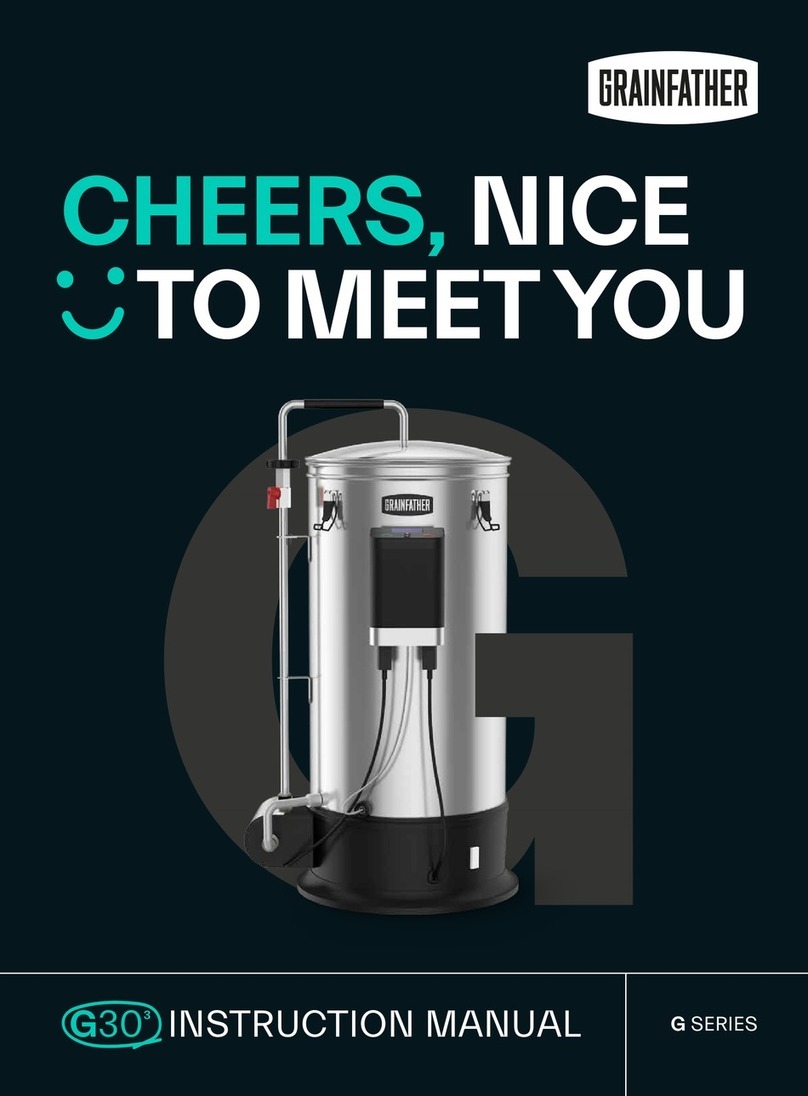
Grainfather
Grainfather G Series instruction manual

Klarstein
Klarstein 10031629 manual
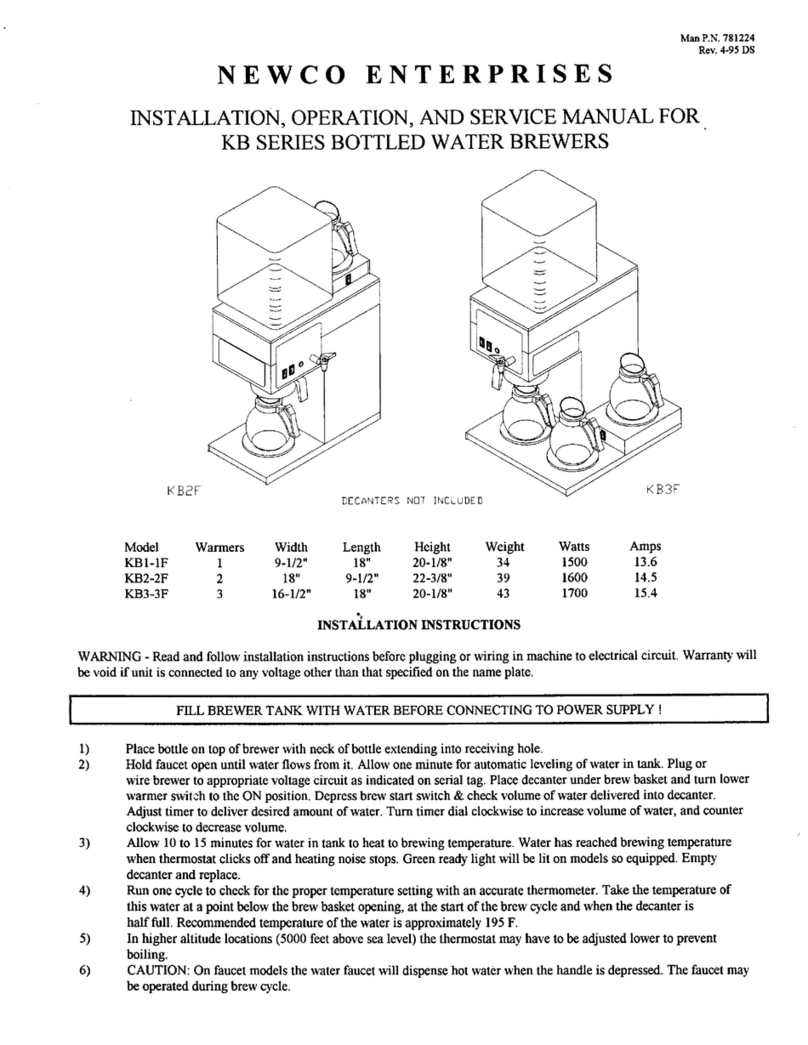
Newco
Newco KB1 Installation, operation and service manual

Curtis
Curtis Gemini Satellite user guide
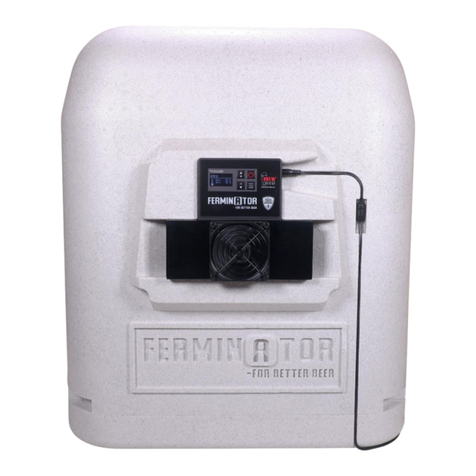
Brewolution
Brewolution M07-3 instruction manual
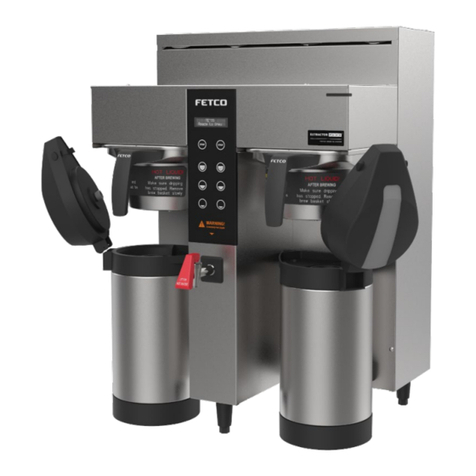
Fetco
Fetco Extractor Plus CBS-1231 Users guide and operator instructions
